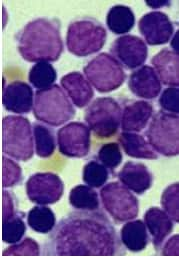Leukemia Symptoms
Leukemia is a cancer of the blood or bone marrow characterized by an abnormal proliferation of blood cells, usually white blood cells (leukocytes). It is part of the broad group of diseases called hematological neoplasms. Damage to the bone marrow, by way of displacing the normal marrow cells with increasing numbers of malignant cells, results in a lack of blood platelets, which are important in the blood clotting process. This means people with leukemia may become bruised, bleed excessively, or develop pinprick bleeds (petechiae).
White blood cells, which are involved in fighting pathogens, may be suppressed or dysfunctional, putting the patient at the risk of developing infections.
Finally, the red blood cell deficiency leads to anemia, which may cause dyspnea. All symptoms may also be attributable to other diseases; for diagnosis, blood tests and a bone marrow biopsy are required.
•fever, chills and other flu-like symptoms
•weakness and fatigue
•loss of appetite (weight)
•swollen or bleeding gums
•neurological symptoms (headache)
•enlarged liver and spleen
Acute vs. Chronic Leukemia
Leukemia is clinically and pathologically split in to its acute and chronic forms.
Acute leukemia is characterized by the rapid growth of immature blood cells. This crowding makes the bone marrow unable to produce healthy blood cells. Acute forms of leukemia can occur in children and young adults. (In fact, it is a more common cause of death for children in the U.S. than any other type of malignant disease). Immediate treatment is required in acute leukemias due to the rapid progression and accumulation of the malignant cells, which then spill over into the bloodstream and spread to other organs of the body. If left untreated, the patient will die within months or even weeks.
Chronic leukemia is distinguished by the excessive build up of relatively mature, but still abnormal, blood cells. Typically taking months to years to progress, the cells are produced at a much higher rate than normal cells, resulting in many abnormal white blood cells in the blood. Chronic leukemia mostly occurs in older people, but can theoretically occur in any age group. Whereas acute leukemia must be treated immediately, chronic forms are sometimes monitored for some time before treatment to ensure maximum effectiveness of therapy.
Lymphoid vs. Myeloid
Furthermore, the diseases are classified according to the type of abnormal cell found most in the blood.
When leukemia affects lymphoid cells (lymphocytes and plasma cells), it is called lymphocytic leukemia.
When myeloid cells (eosinophils, neutrophils, and basophils) are affected, the disease is called myeloid or myelogenous leukemia.

